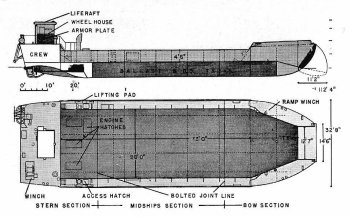![]() The Pacific War Online Encyclopedia
The Pacific War Online Encyclopedia
|
| Previous: LCS Class, Allied Landing Craft | Table of Contents | Next: LCVP Class, Allied Landing Craft |
|  ONI 226 |
LCT Mark 5
|
Tonnage |
133 tons light displacement |
|
Dimensions |
114'2" by 32'8" by 3' |
|
Maximum speed |
10 knots |
| Complement |
13 |
|
Armament |
2 0.50
machine guns 2 20mm Oerlikon AA guns |
| Protection |
2.5" (64mm) plastic on wheelhouse sides and gun positions 0.25" (6mm) STS ramp plate |
| Machinery |
3-shaft Gray diesel (675 shp) |
| Bunkerage |
11.12 tons |
| Range |
700 miles at 7 knots |
|
Capacity |
150 tons = 9 trucks or 5 light or 3 heavy tanks or 150 troops |
| Variants |
Marks 1 to 4 were British designs that were
considerable larger than Mark 5 (226 to 350 light tons displacement)
but were rejected for mass production in the U.S. Mark 6 was slightly larger but did not vary
significantly in seakeeping. |
Landing Craft, Tank, or LCTs, were small seagoing landing craft that were similar to LCIs, but were specialized for landing vehicles. They had a single large bow ramp and could carry up to four tanks or several trucks. Total cargo capacity was about 150 tons. They were very slow at 10 knots, and short-ranged, which reduced their strategic flexibility considerably.
LCTs were constructed in three welded sections for
shipment overseas. These could be bolted together in the water.
Because of their short range, they were not designed to house their crews for more than a few days at a time. However, in the Southwest Pacific, these craft operated almost continuously for months at a time. This could not have been pleasant for their crews.
The British modified some LCTs as fire support craft,but
this was not done by U.S. forces. However, a number of LCTs were used
as gunboats at Biak by loading tanksonto the LCTs to fire directly into Japanese positions along the coastal escarpment that could not otherwise be reached.
As with all landing craft built in the
United States, a large fraction went to Britain as Lend-Lease.
The following table gives total production. About 30% of this
was
allocated to the Pacific until the final year of the war, when most of
the amphibious fleet began to be shifted to the Pacific.
| 1942-6 |
1 |
| 1942-7 |
1 |
| 1942-8 |
45 |
|
1942-9 |
156 |
|
1942-10 |
152 |
|
1942-11 |
101 |
| 1942-12 |
9 |
| 1943-1 |
5 |
| 1943-2 |
0 |
| 1943-3 |
0 |
| 1943-4 |
0 |
| 1943-5 |
0 |
| 1943-6 |
1 |
| 1943-7 |
0 |
| 1943-8 |
10 |
| 1943-9 |
32 |
| 1943-10 |
44 |
| 1943-11 |
46 |
| 1943-12 |
38 |
| 1944-1 |
65 |
| 1944-2 |
84 ONI 226 |
| 1944-3 |
81 |
| 1944-4 |
100 |
| 1944-5 |
83 |
| 1944-6 |
76 |
| 1944-7 |
79 |
| 1944-8 |
71 |
| 1944-9 |
67 |
| 1944-10 |
48 |
| 1944-11 |
28 |
| 1944-12 |
12 |
References
Leighton and
Coakley (1955)
Morison
(1953)
Naval
Historical Center (accessed 2008-5-13)
Smith (1953; accessed 2013-6-22)
World War II Landing
Craft Tanks (accessed 2008-5-13)
The Pacific War Online Encyclopedia © 2006, 2008-2009, 2012-2013 by Kent G. Budge. Index